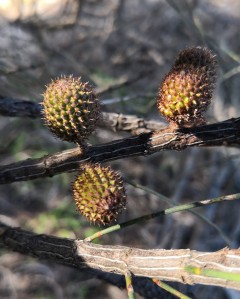
Common names: Drooping Sheoak, Drooping She-oak
Taxonomic name: Allocasuarina verticillata
Family: Casuarinaceae
Habitat: Widespread coastal, sandy
Form: Tree to 10 metres
Flowering time: All year
Ngarrindjeri name: Kolgi, Kotgee
Kaurna name: Karko
Description
Drooping Sheoaks are small to medium size, spreading trees with dense drooping foliage of green branchlets. The branchlets break apart at joints, exposing tiny, tooth-like leaf scales that can take a bit of effort to see.
They have separate male and female trees. On male trees, flower spikes form at the end of branchlets in Autumn and become orange tassels in Winter. The female trees produce small flowers, which are masses mass of red threads, on older branches over Winter.
The females produce hard seed cones that can persist as dry cones on a tree for years.





Uses
The male has huge amounts of pollen producing material at the end of the branchlets. This can be shaken off or can be seen blowing off in a strong breeze. I use it in same way that some folks use the pollen from the introduced Pine tree (Pinus sp) as a dusting added to meals eaten on the trail. I’ve not come across Aboriginal references to eating it in this way.
Very young Sheoak cones can be eaten when young and green. They can be eaten raw to relieve thirst while foraging or added to cooking. There are stories of desert groups chewing on Sheoak leaves to reduce thirst.
Sheoaks produce a very hard wood which is excellent for making boomerangs (often the root is used because of its natural bend), clubs and digging sticks.
The Drooping Sheoak has an interesting property that makes it kind of magical. The slightest breeze will start the branchlets moving and rustling together, making a low, whispering sound, just like someone is nearby whispering to you. This is reputed to be the voices of spirits in the tree canopy. I’ve been under them and heard this even when I can swear that there was no wind movement – maybe the breeze was higher up, maybe it was only a tiny puff that I didn’t notice…or maybe…
